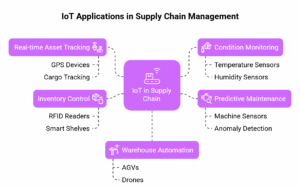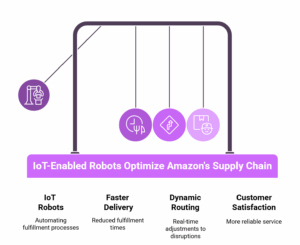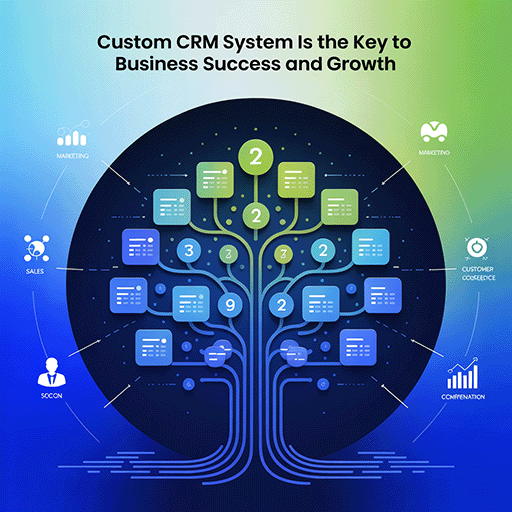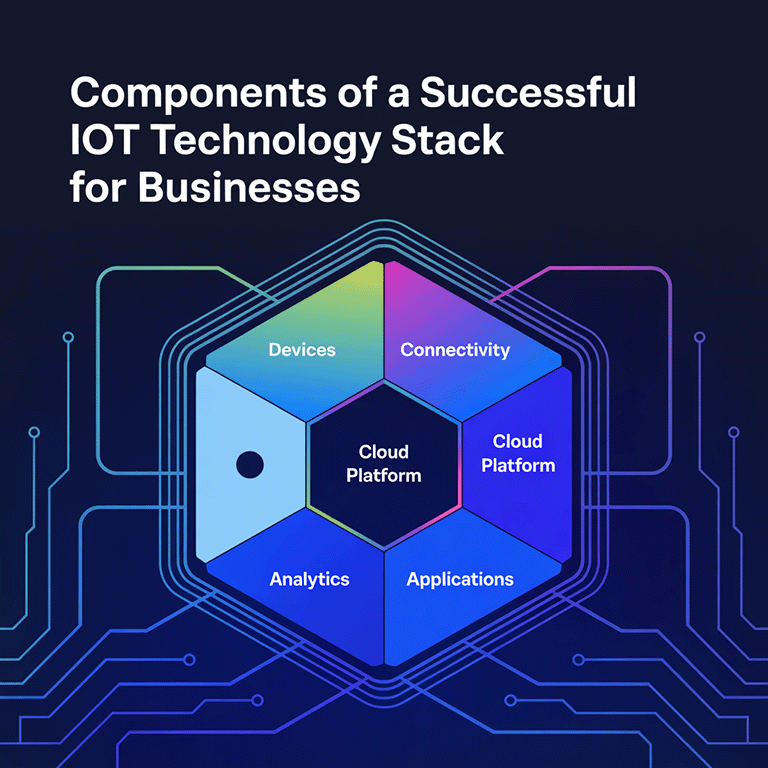The use of IoT in supply chain management is transforming how companies monitor products, control inventory, and streamline processes. A new era of more intelligent supply chain strategies has been made possible by the ability to connect physical assets with sensors, devices, and software. The Internet of Things (IoT) changes every link in the chain, from real-time data collection to predictive analytics, increasing the transparency and agility of supply networks.
Staying competitive in the ever-changing logistics landscape of today requires using data-driven tools to identify inefficiencies, cut down on delays, and satisfy growing customer demands. Businesses are increasing visibility, automating processes, and reducing operating expenses as they implement IoT supply chain solutions.
What is IoT in Supply Chain?
Simply put, it’s the integration of intelligent, networked devices that collect, send, and evaluate data at every stage of the supply chain, from raw materials to final delivery.
GPS trackers, RFID tags, temperature sensors, wearable technology, drones, and automated guided vehicles (AGVs) are some examples of IoT-enabled systems. They provide unmatched insights and control over logistics operations when combined with platforms such as ERP or WMS.
Learn How AI and IoT work together to build smart, autonomous supply chains.
How is IoT Used in Supply Chain?
Knowing how IoT is used in supply chains shows how widely it has affected various industries:
- Tracking assets in real time: GPS-enabled devices track the location of vehicles and cargo while they are in transit.
- Condition monitoring: For delicate items, sensors measure temperature, vibration, and humidity.
- Predictive maintenance: To avoid malfunctions, IoT identifies abnormalities in machines.
- Inventory control: RFID readers and smart shelves make stock tracking automatic.
- Automation of warehouses: AGVs and drones maximise restocking, packing, and picking.
These use cases increase customer satisfaction, decrease human error, and streamline operations.

IoT in Supply Chain Example: Cold Chain Monitoring
Cold chain monitoring in the food and pharmaceutical sectors is a powerful illustration of IoT in supply chains. Perishables and vaccines need to be refrigerated constantly. Throughout storage and transportation, IoT sensors continuously check the temperature, notifying teams instantly if a shipment deviates from safe limits.
This keeps products from being lost, guarantees that safety rules are followed, and increases consumer confidence. IoT-enabled cold chain logistics are already being used by companies like Nestlé and Pfizer to preserve quality and minimise spoiling.
IoT Supply Chain Applications Across Industries
The range of IoT supply chain applications is expanding rapidly across sectors:
- Retail: Smart shelves, real-time inventory updates, and customer demand forecasting
- Manufacturing: Production monitoring, asset utilization, and predictive analytics
- Automotive: Vehicle part tracking, warehouse robotics, and fleet optimization
- Agriculture: IoT sensors for harvest logistics and soil-to-shelf transparency
- Healthcare: Secure tracking of medical equipment and drug delivery status
As shown by McKinsey, the potential value of IoT in logistics and supply chain could reach $1.9 trillion per year in 2025.

Internet of Things in Supply Chain Management: Real-World Use
In supply chain management, the term “Internet of Things” refers to a network of intelligent assets in the real world. IoT is already being used by logistics firms like FedEx and DHL to automate warehouse operations, forecast package delivery times, and manage international fleets.
Maersk, for example, provides real-time tracking and status updates via IoT sensors on shipping containers. This minimises idle time at ports and enables more efficient resource allocation. In a similar vein, Walmart uses IoT to decrease food waste in perishable departments and increase shelf stock accuracy.
By integrating with AI solutions, IoT devices can go beyond monitoring to support smart automation and optimization.
IoT in Logistics and Supply Chain: The Bigger Picture
It is impossible to overestimate the wider effects of IoT on supply chains and logistics. Strategic agility is just as important as operational efficiency. IoT gives businesses the resilience they need to stay ahead in a globalised market where supply chain disruptions, such as pandemics or geopolitical events, can seriously impair operations.
IoT solutions, when combined with AI and machine learning, can assist in real-time disruption prediction, shipment rerouting, and dynamic inventory allocation based on changing demand.
Read about Key Components of a Successful IoT Technology Stack for Businesses.
IoT in Supply Chain Case Study: Amazon
To move items more quickly and precisely, the retail fulfilment centres employ a network of IoT-enabled robots. Amazon has significantly shortened fulfillment times while maintaining human workers’ attention on high-value tasks by combining sensors and AI.
IoT also powers its dynamic routing and real-time delivery updates, which allow the system to instantly adjust to last-minute order changes, traffic jams, and weather disruptions. Even during the busiest holiday seasons, when volumes are at their highest, this guarantees that packages will always arrive on time. Logistics teams can proactively manage delivery routes, cut down on idle time, and minimise failed deliveries by using IoT devices to feed data into centralised platforms. By providing a quicker, more dependable service, this example shows how investing in intelligent infrastructure not only increases supply chain efficiency but also dramatically raises customer satisfaction. It establishes a new benchmark for operational excellence in the era of digitalisation.

What is the Future of IoT in the Supply Chain?
Over the past few years, the blockchain’s share of the insurance market has grown exponentially. The global market was estimated to be
What role will IoT play in the supply chain going forward? The future is bright and ambitious. The next generation of IoT will provide even faster insights and more decentralised decision-making as 5G networks grow and edge computing becomes more widely available.
We can expect:
- Hyper-automated warehouses with autonomous vehicles and drones
- Real-time collaboration between machines and humans
- Blockchain-integrated IoT for tamper-proof data exchange
- AI-powered demand sensing and predictive analytics at scale
- Sustainability tracking to measure and reduce carbon footprints
In short, the future of IoT-based supply chain management is autonomous, intelligent, and sustainable.
Internet of Things Supply Chain Market Size
The supply chain IoT market is expanding quickly. The global IoT in logistics market was estimated to be worth $34 billion in 2022 and is expected to reach $114 billion by 2030, according to Fortune Business Insights.
This enormous expansion is a result of growing adoption in a variety of industries, including manufacturing, retail, energy, and agriculture. Businesses are coming to understand that the Internet of Things is not a luxury but rather a necessity as digital transformation becomes more and more important.
Build Smarter Supply Chains with LITSLINK
IoT integration in supply chain management is emerging as a key component of competitive strategy as companies continue to digitise their operations. The benefits are indisputable, ranging from cost savings and increased visibility to better customer satisfaction and sustainability.
Our specialty at LITSLINK is developing complete IoT and AI solutions that assist businesses in updating their supply chains. We provide the technical know-how and industry insight to help you achieve your goals, whether they involve automating warehouse operations, improving
logistics, or tracking shipments.
We create and deploy customised IoT systems that are safe, scalable, and expansion-ready, seamlessly integrating with your existing infrastructure.
Luckily, we have great experience in custom software and IoT development. We can do that for you, too. Just contact us and let’s get started!





